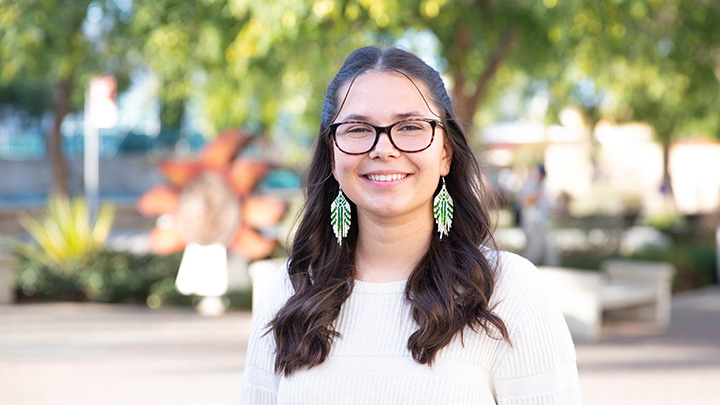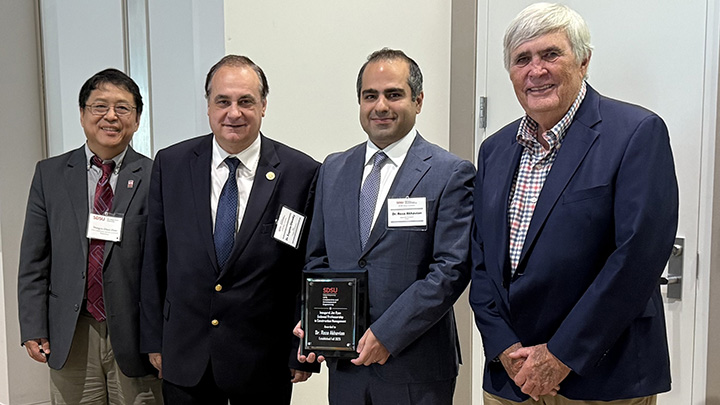The top five takeaways from SDSU’s Re:Border Conference 2024
This year’s conference was the largest yet, bringing together a diverse binational group of students, faculty and policy leaders to build a better border region
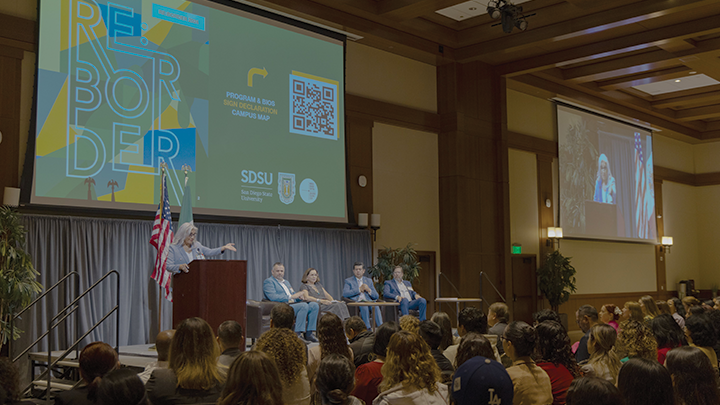
Some attendees woke at 1 a.m. to make sure they caught buses in Mexico headed to San Diego State University. Others traveled from as far as Oaxaca and the American Midwest to campus.
They joined over 800 attendees last week for SDSU’s sixth annual Re:Border conference — a gathering of students, researchers, business and community leaders, and policy experts working on challenges facing the Cali-Baja region. SDSU conducts Re:Border in partnership with Universidad Autónoma de Baja California and El Colegio de Frontera Norte in Baja California, México.
This year’s theme, Designing Oportunidades, builds off the San Diego-Tijuana region’s designation as joint World Design Capital (WDC) cities. WDC will make recommendations around cross-border transportation, planning, public spaces, binational education and other projects to knit together the tapestry of the binational region.
For the first time, Re:Border this year featured an education strand where panelists explored topics ranging from preparing cross-border renewable energy workers to designing a master's degree curriculum in transborder intercultural education.
Here are the top takeaways from this year’s conference.
 Open the image full screen.
Open the image full screen.
The nation’s transborder institution
In her opening remarks at the conference, SDSU President Adela de la Torre emphasized the importance of border communities taking charge in shaping the region’s future.
“You know, many people want to define the border for us,” she said. “It is important for us not to forget that if we allow people to define us, we will never be able to create our own destiny.
“It doesn’t matter what the political climate is,” she continued. “We are here. We are the anchors.”
To that end, SDSU’s goal is to be the leading transborder university in the country.
“SDSU is very much rooted in being a transborder institution,” said de la Torre. “Indeed, it is part of our strategic plan, and people who know me say we are going to be defined as the nation’s transborder institution.”
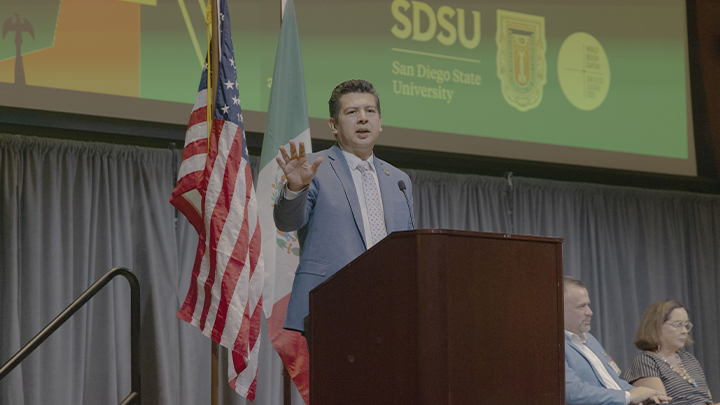 Open the image full screen.
Open the image full screen.
Joint degrees with international universities
Legislation introduced by California Assembly member David Alvarez, D-San Diego, allows California State University to offer joint undergraduate and graduate degrees with binational and international institutions.
Gov. Gavin Newsom signed AB 2633 into law in September to foster binational partnerships and academic mobility. It was supported by the Imperial Valley Economic Development Corporation, which noted the many students who travel to and from Mexico for their studies, particularly in STEM fields.
“It started because of conversations (at Re:Border) six years ago,” said Alvarez, a speaker at this year’s opening ceremony. “You now will be able to receive a degree at a Mexican institution, and at the same time receive a degree at one of our CSUs here in California.”
 Open the image full screen.
Open the image full screen.
Think Tank
A marquee event at Re:Border is a Shark Tank-style pitch contest called Think Tank. Eight teams presented research ideas to a binational panel of judges in hopes of winning micro-grants of $2,500 each.
“Connecting Horizons” won for a proposal on peer mentoring for migrant children. It links children new to the border environment, including those living in shelters, with young, recent migrants who have experience in the United States to share their knowledge and advice.
The project is led by Porfiria del Rosario Bustamante de la Cruz, professor and researcher, Universidad Autónoma de Baja California (UABC); Edmund 'Ted' Hamann, professor of education policy at the University of Nebraska-Lincoln; and Laura Marcela Rodríguez Benjumea, a doctoral student at UABC.
The second winning proposal calls for the creation of a scientific binational laboratory as a joint project of Universidad Autónoma de Baja California and SDSU. The project aims to increase coordination for cross-border researchers working on environmental problems that impact communities in the borderlands. This proposal was directed by Linda Lara-Jacobo, assistant professor in the School of Public Health at SDSU Imperial Valley; Ernesto Beltran Partida, biomaterials professor at UABC; and Benjamin Valdez Salas, science and engineering professor at UABC.
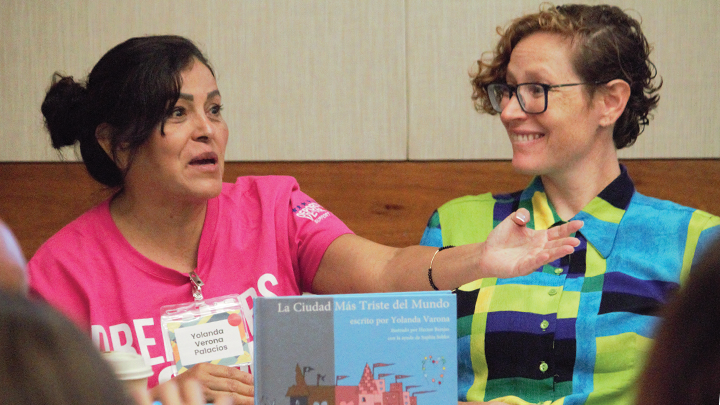 Open the image full screen.
Open the image full screen.
Arts Alive: A tale of deportation for children
In 2014, Yolanda Verona Palacios was deported. Her daughter was 15 years old at the time. She didn’t return to the U.S. until 2022. The pain of that family separation inspired Palacios to collaborate with artist and educator Sophia Sobko on bilingual children's books, including “La Luciérnaga y Sus Estrellas Fugaces” (“The Firefly and Her Shooting Stars”) and “La Ciudad Más Triste del Mundo” (“The Saddest City in the World”).
During this emotional panel, Palacios shared her journey, and the struggles of others facing family separation through deportation. While she lives in San Diego now, Palacios plans to return to Tijuana to advocate for those seeking to rejoin loved ones.
“There are many children who do not even know their families because of the separation,” she said. “We fight to avoid that because it should not be that way. I do hope that individuals who read this book will better understand with more compassion and empathy.”
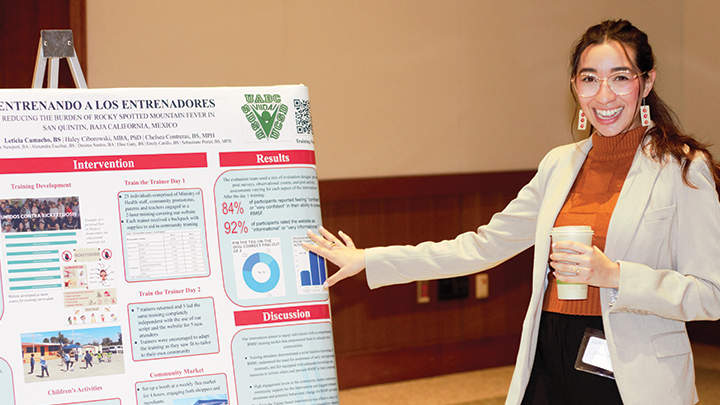 Open the image full screen.
Open the image full screen.
Showcasing Research
Nearly 20 poster presenters displayed their binational research collaborations and projects during a 90-minute session at Re:Border. Lorena Broca, a professor at La Salle University in Oaxaca, exhibited her work on architectural preservation and identity, focused on heritage structures and sites in central Oaxaca. SDSU’s long-running public health VIIDAI collaboration with the University of California San Diego and Mexican partners displayed its work to thwart a Rocky Mountain spotted fever in San Quintin, Mexico.
For the past four years, SDSU engineering students have collaborated with peers at Centro de Enseñanza Técnica y Superior (CETYS) on year-long capstone projects. SDSU Mechanical Engineering Lecturer Scott Shaffar explained a poster of some of their work.
“There have been different things that we have done,” he said, “like the 3D-printed aircraft competition with the CSUs, and we invited CETYS. We also had a joint competition with NASA to do a lunar rover.”
While the lunar rover project is complete, the 3D-printed fixed wing aircraft contest is re-occurring. SDSU and CETYS teams are expected to fly their planes in the competition held at Cal State LA on May 31, 2025.
In closing, Cristina Alfaro, SDSU’s associate vice president of International Affairs, said millions of people live in Southern California and metropolitan Tijuana who share one of the largest and most productive spaces on earth.
“Re:Border is a powerful space where education leaders, researchers, students, community members, and political experts, from both sides of the border, collaborate to build on the assets and work to find solutions to challenges in what has become a coastal megalopolis transborder region,” she said.

